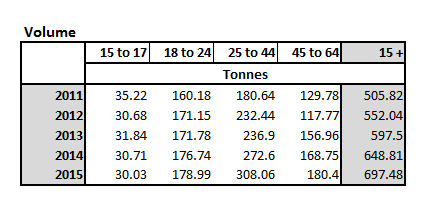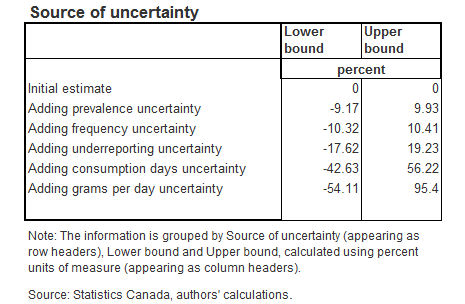The Economics and Statistics Division maintains archives of previous publications for accountability purposes, but makes no updates to keep these documents current with the latest data revisions from Statistics Canada. As a result, information in older documents may not be accurate. Please exercise caution when referring to older documents. For the latest information and historical data, please contact the individual listed to the right.
<--- Return to Archive
For additional information relating to this article, please contact:
December 18, 2017EXPERIMENTAL ECONOMIC ESTIMATES OF CANNABIS CONSUMPTION Today, Statistics Canada published the results of a study on the estimated consumption of cannabis in Canada.
Consumers
Records show that cannabis use increased rapidly during the 1960s and 1970s. Initially only the younger generation was included in studies, but today (up to 2015) prevalence has included users across all age groups. Given estimates of cannabis use by age group (adjusted for under reporting), an age-related profile of cannabis consumption can be estimated.
In 2015, it is estimated that 67% (two-thirds) of cannabis uses are over age 24, while persons aged 15-17 account for less than 6%.

Consumption
Two factors are required to estimate the volume of cannabis consumed: 1) number of consumption days 2) quantity consumed per day. These factors, adjusted for age categories, were derived from previous studies. Studies show that the overall cannabis population is increasing, and those consumers tend to be older and consume more per year.
In Canada 2015, it is estimated that consumption of cannabis for the population aged 15+ increased to 697.48 tonnes, from 648.81 tonnes the previous year.

Uncertainty
As far as estimates go, the study realizes that even with the data going back to 1960, the results are uncertain.
- The number of grams consumed per day is the largest uncertainty factor where estimates could be reduced by 54% or increased by 95%
- Consumption days could be reuced by 42% or increased by 56%.
- Underreporting could be reduced by 18% or increased by 19%.
- Other uncertainties could subtract or add another 9 to 10% to the estimates.

Implied Value
Even with uncertainties, the implied value of cannabis sales in Canada would be between $5.0 and $6.2 billion. In comparison, the beer market is about $9 billion and the wine market about $7 billion per year.
For more information, click on the link below.
Source: Experimental Estimates of Cannabis Consumption
<--- Return to Archive